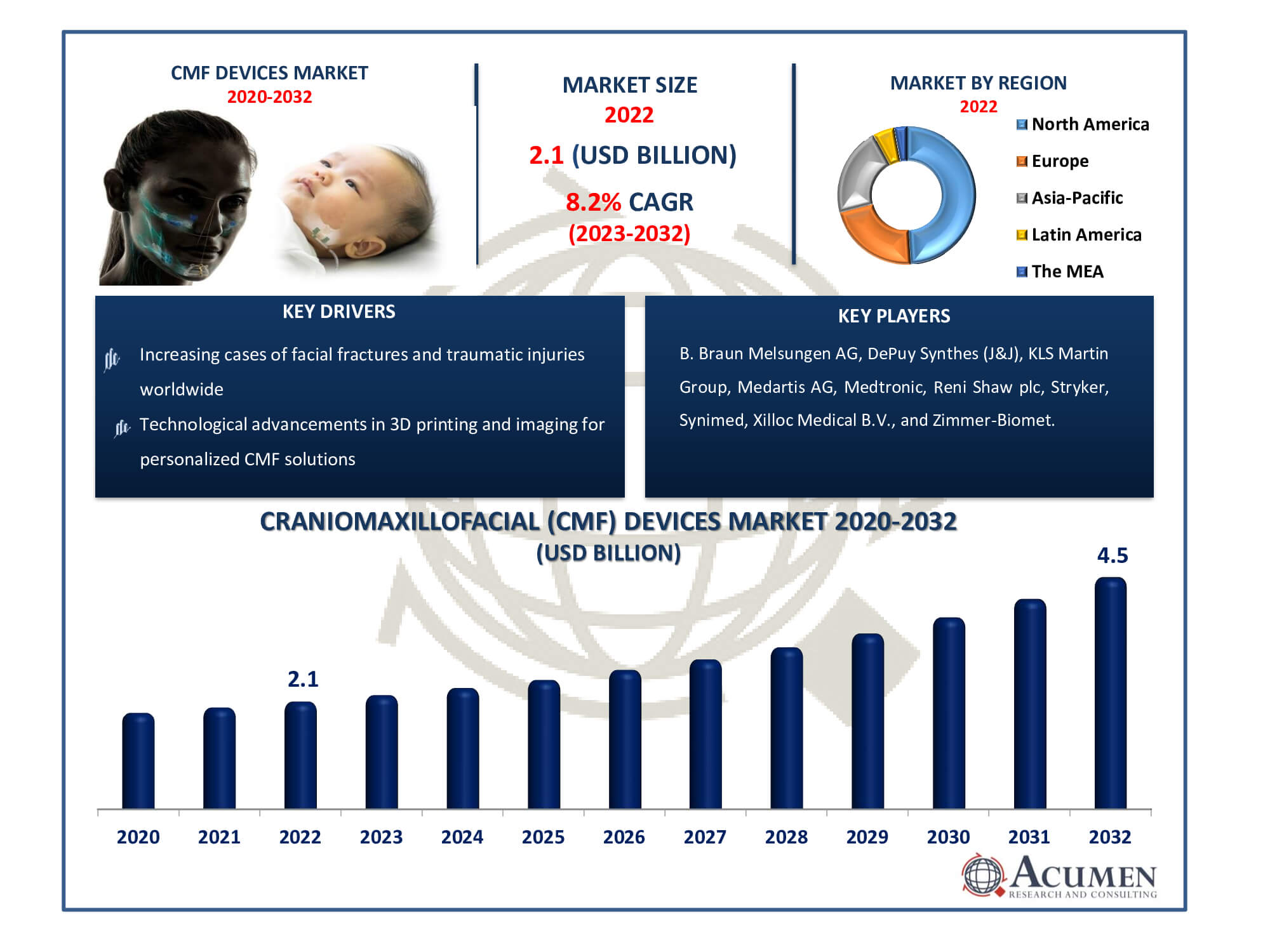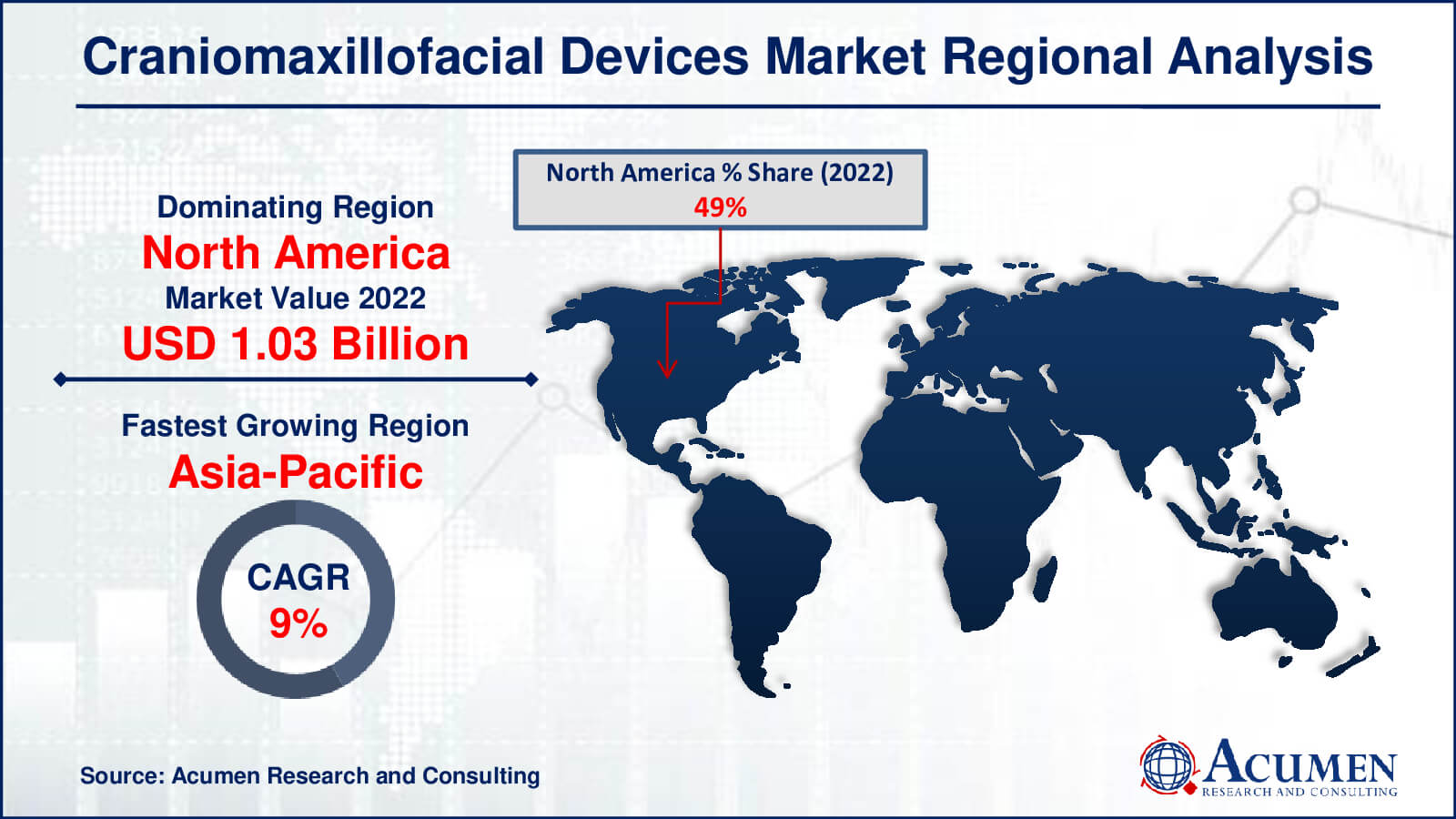February 2023
Craniomaxillofacial Devices Market Size accounted for USD 2.1 Billion in 2022 and is estimated to achieve a market size of USD 4.5 Billion by 2032 growing at a CAGR of 8.2% from 2023 to 2032.
The Craniomaxillofacial Devices Market Size accounted for USD 2.1 Billion in 2022 and is estimated to achieve a market size of USD 4.5 Billion by 2032 growing at a CAGR of 8.2% from 2023 to 2032.
Craniomaxillofacial Devices Market Highlights

Specialized instruments called craniomaxillofacial (CMF) devices are employed during procedures involving the jaws, face, and skull. These devices play a critical role in the treatment of diseases, congenital disabilities, and accidents-related injuries, deformities, and abnormalities in these regions. They include surgical equipment, plates, screws, and implants designed to meet the specific architecture of the cranial and facial regions. CMF devices help stabilize fractures, rebuild face bones, and improve the afflicted areas' appearance and functionality. They are made to help the healing of bones, straighten facial features, and make precise surgery easier. The market for CMF devices is driven by improvements in patient outcomes, tailored solutions, and technology developments. The development of these devices is driven by ongoing innovation in materials, design, and surgical procedures, which increases their efficacy in treating a variety of craniofacial diseases.
Craniomaxillofacial Devices Market Dynamics
Market Drivers
Market Restraints
Market Opportunities
Craniomaxillofacial Devices Market Report Coverage
| Market | Craniomaxillofacial (CMF) Devices Market |
| Craniomaxillofacial (CMF) Devices Market Size 2022 | USD 2.1 Billion |
| Craniomaxillofacial (CMF) Devices Market Forecast 2032 | USD 4.5 Billion |
| Craniomaxillofacial (CMF) Devices Market CAGR During 2023 - 2032 | 8.2% |
| Craniomaxillofacial (CMF) Devices Market Analysis Period | 2020 - 2032 |
| Craniomaxillofacial (CMF) Devices Market Base Year |
2022 |
| Craniomaxillofacial (CMF) Devices Market Forecast Data | 2023 - 2032 |
| Segments Covered | By Product, By Material, By Application, By End-User, And By Geography |
| Regional Scope | North America, Europe, Asia Pacific, Latin America, and Middle East & Africa |
| Key Companies Profiled | B. Braun Melsungen AG, DePuy Synthes (J&J), KLS Martin Group, Medartis AG, Medtronic, Reni Shaw plc, Stryker, Synimed, Xilloc Medical B.V., and Zimmer-Biomet. |
| Report Coverage |
Market Trends, Drivers, Restraints, Competitive Analysis, Player Profiling, Covid-19 Analysis, Regulation Analysis |
Craniomaxillofacial Devices Market Insights
Cases of facial fractures are expected to increase, primarily due to combat sports, accounting for around 80%. The nose and teeth are the most commonly affected areas requiring greater attention in preventive measures. Among all combat sports, kickboxing is identified as the most injurious, contributing significantly to maxillofacial traumas. Consequently, there is a heightened demand for Craniofacial Reconstruction Implants (CRI).
Moreover, heightened consumer awareness stands as a major factor driving market growth. Initiatives such as sampling programs aimed at increasing awareness of CMF surgeries, led by organizations like the American Society of Craniofacial Surgeons (ASCFS) and the International Society of Craniofacial Surgery (ISCFS), have been pivotal. Furthermore, the growing geriatric population and increased healthcare spending are anticipated to bolster the demand for CMF procedures in the forecast period. This trend is expected to create lucrative growth opportunities in the market, especially with the integration of advanced 3D implants in cranial reconstructive surgeries, thereby enhancing adoption rates.
Tight regulatory approvals are a major barrier to the market for CMF devices. These medical devices protracted and stringent approval procedures frequently cause delays in their release onto the market, which hinders innovation and delays patients access to necessary products on time.
In the market for CMF devices, integrating cutting-edge materials like bioresorbable materials offers a bright future. Because these novel materials dissolve gradually in the body, they do not require removal operations and carry fewer hazards, which may lead to a reduction in long-term consequences. In addition to improving patient outcomes and advancing the development of next-generation CMF implants and devices, their biocompatibility and capacity to promote tissue healing represent a transformative possibility that will open the door to safer and more effective procedures in craniofacial operations.
Craniomaxillofacial Devices Market Segmentation
The worldwide market for craniomaxillofacial devices is split based on product, material, application, end-user, and geography.
CMF Devices Market By Products
According to craniomaxillofacial devices industry analysis, the product segment with a market share of over 70% was led by CMF plate and screw fastening in 2022. Widely used in various operations like deformity correction, orthognathic surgery, tumor removal, and pediatric surgery, CMF plates and screws are highly versatile.
Cranial flap fixing devices, applied in neurosurgery, ENT, and plastic surgeries, facilitate scalp opening in craniotomy procedures and corrections of facial distortions. The development of this segment is fueled by technological advancements, such as the titanium cranial attaching system, enhancing device efficacy. Short-term expectations include the rise of bio-absorbable implants based on polymers.
The replacement TMJ devices are projected to exhibit the fastest CAGR in the craniomaxillofacial (CMF) devices industry forecast period, attributed to increased incidents of road and sports accidents causing cranial and facial fractures. TMJ devices aid in jaw substitution surgeries, supporting fused joints, fractures, degenerated joints, orthodontic and dental abnormalities, and arthritis. These devices alleviate jaw pain, eating disruptions, and improve mouth opening capacity. The TMJ substitution segment shows rapid growth, especially with rising demand for cosmetic surgeries like chin enhancements and jaw substitutions to enhance facial aesthetics.
CMF Devices Market By Materials
The general market for materials in CMF devices is predominantly led by metal implants due to their various advantages, including lower corrosiveness, rigid fracture support, relatively lower costs compared to bioabsorbable alternatives, and wider market penetration. Metals, being less corrosive and providing physiological support to fractures, are extensively utilized in CMF surgeries. Titanium and its alloys stand out among these metals due to their lightweight nature, inert properties, high tissue acceptance levels, and corrosion resistance, making them the most commonly employed in CMF reconstruction, particularly in the mandibular system.
The use of these implants not only eliminates the need for a second surgery required with metal implants but also facilitates easy assimilation by the body, indicating lucrative growth potential during the craniomaxillofacial devices market forecast period. Factors expected to drive market growth include technological advancements in CMF operations, leveraging self-enhanced technologies with biocompatible, easily manageable, degradable, and reliable properties.
Furthermore, anticipated government initiatives aimed at raising awareness about CMF surgeries to address deformities are expected to expand the consumer base and drive growth in this sector in the Craniomaxillofacial Devices Market forecast years.
CMF Devices Market By Applications
The largest application sector in the market for CMF devices is orthognathic and dental surgery, which deals with treating abnormalities of the jaw and face. It includes operations including dental reconstructions, bite realignments, and corrective surgery. Because there is a strong demand for procedures that address both functional and cosmetic issues in problems connected to the jaw and teeth, this market category is dominant.
Moreover, the introduction of surgical-navigation technology for ENT procedures is anticipated to drive growth in the craniomaxillofacial devices market. The anticipated benefits of this technology, such as user-friendly interfaces, 3D displays, and real-time updates of virtual anatomy, are poised to accelerate adoption in the near future.
Plastic surgery is expected to witness the fastest growth, propelled by increased awareness, demand, and expenditure on cosmetic procedures, particularly in developing economies like the U.S. Additionally, the expected rise in the utilization of CFSD (Craniofacial Surgery Devices) supports this segment's growth. CFSD finds application in Maxillofacial Oncologic and Reconstructive Surgery (MORS).
CMF Devices Market By End-Users
In terms of craniomaxillofacial devices market analysis, the hospitals offer a wide range of specialised treatment and surgical procedures for disorders related to the craniofacial region, making them the largest end-user category in the CMF devices market. They provide sophisticated infrastructure, specialised medical knowledge, and a large selection of CMF devices, making them hubs for intricate surgeries. Hospitals are the first choice for complex craniofacial operations and post-operative care because they can accommodate a wide range of patient needs and guarantee thorough care and access to a full spectrum of CMF treatments.
CMF Devices Market By Regions
North America
Europe
Asia-Pacific
Latin America
The Middle East & Africa

Craniomaxillofacial Devices Market Regional Analysis
North America held a market share of over 49% in 2022, attributed to the rising instances of facial deformities due to increased industrialization. This growth was propelled by the introduction of advanced cranial implants, surging demand for minimally invasive surgeries, access to cutting-edge healthcare facilities, and heightened patient awareness.
In the U.S., with the burgeoning demand for ambulatory services and a corresponding increase in associated infections, it dominated the revenue share. Moreover, the government's mounting pressure to implement stringent security protocols is expected to drive growth in the foreseeable future.
Asia-Pacific emerges as the fastest-growing region, spurred by untapped opportunities, ongoing enhancements in healthcare infrastructure, economic advancements, and a rising level of patient awareness.
Craniomaxillofacial Devices Market Players
Some of the top craniomaxillofacial devices companies offered in our report includes B. Braun Melsungen AG, DePuy Synthes (J&J), KLS Martin Group, Medartis AG, Medtronic, Reni Shaw plc, Stryker, Synimed, Xilloc Medical B.V., and Zimmer-Biomet.
Looking for discounts, bulk pricing, or custom solutions? Contact us today at sales@acumenresearchandconsulting.com
February 2023
October 2018
March 2024
May 2023